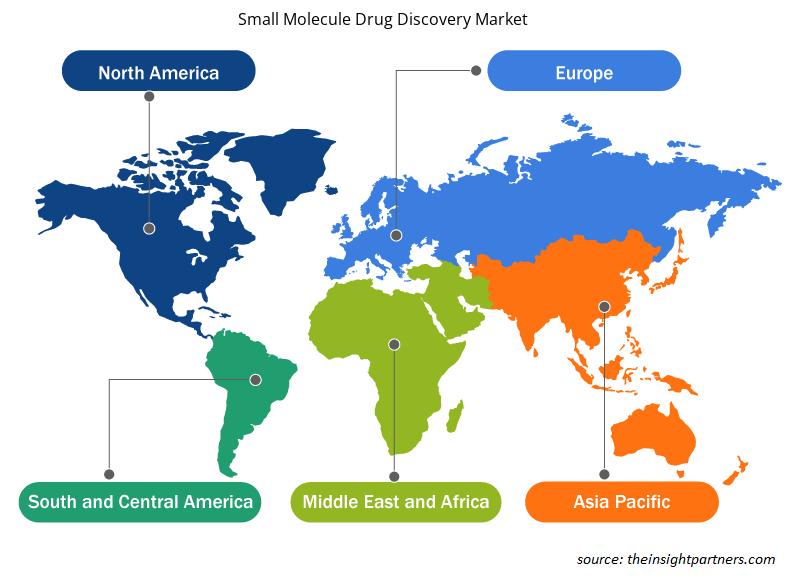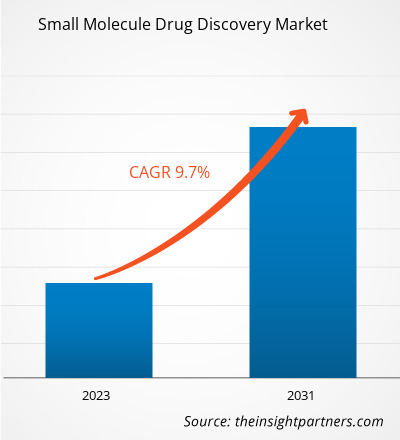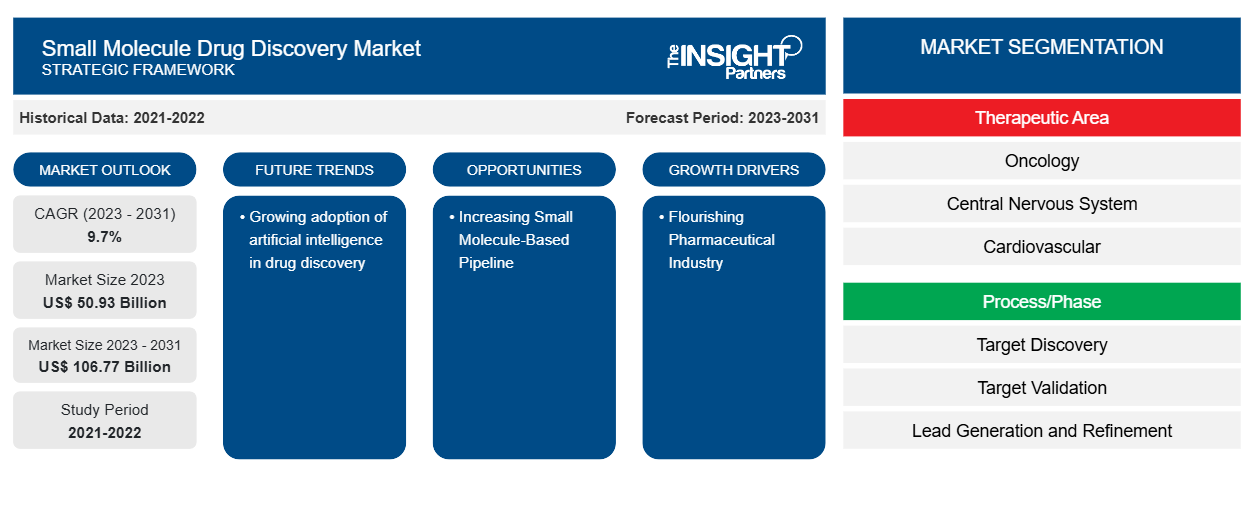소분자 약물 발견 시장 규모는 2023년 509억 3,000만 달러에서 2031년까지 1,067억 7,000만 달러로 성장할 것으로 예상됩니다. 이 시장은 2023~2031년 동안 9.7%의 CAGR을 기록할 것으로 예상됩니다. 약물 발견에 인공지능을 점점 더 많이 도입하는 것은 시장의 미래 트렌드로 작용할 가능성이 높습니다.
소분자 약물 발견 시장 분석
소분자 약물 발견 시장은 주로 제약 및 생명공학 기업의 신약 발견을 위한 R&D 증가, 정부 이니셔티브, 암 유병률에 의해 주도됩니다. 시장 확장에 기여하는 다른 요인으로는 임상 시험의 세계화, 관련 기술의 급속한 발전, 임상 시험을 수행하기 위한 CRO에 대한 수요 증가가 있습니다. 또한 소분자 기반 파이프라인의 증가는 소분자 약물 발견 시장의 성장 기회로 작용합니다.
소분자 약물 발견 시장 개요
아시아 태평양 지역은 예측 기간 동안 가장 높은 CAGR을 기록할 것으로 예상됩니다. 기술 발전의 급증, 아시아와 서양 국가 간의 협업(게놈 연구 개발을 위한)의 급증, DNA 시퀀싱 가격의 하락, 유전 및 기타 표적 질병의 유병률 증가가 아시아 태평양 소분자 약물 발견 시장을 촉진하고 있습니다. 아시아 태평양 시장은 GDP 증가로 인해 제약 산업이 성장함에 따라 촉진될 것으로 예상됩니다. 또한 가처분 소득의 증가로 인해 첨단 의료 기술의 도입이 촉진되고 있습니다. 따라서 앞서 언급한 요인으로 인해 소분자 약물 발견 시장에 엄청난 잠재력이 있습니다.
귀하의 요구 사항에 맞게 이 보고서를 사용자 정의하세요
이 보고서의 일부 또는 국가 수준 분석, Excel 데이터 팩을 포함하여 모든 보고서에 대한 사용자 정의를 무료로 받을 수 있으며 신생 기업 및 대학을 위한 훌륭한 혜택과 할인 혜택을 이용할 수 있습니다.
-
이 보고서의 주요 시장 동향을 알아보세요.이 무료 샘플에는 시장 동향부터 추정 및 예측까지 다양한 데이터 분석이 포함됩니다.
소분자 약물 발견 시장 동인 및 기회
R&D 활동 급증으로 번창하는 제약 산업
제약 산업은 세계에서 가장 R&D 집약적인 산업 중 하나입니다. 환자의 요구를 충족하는 데 있어 더 큰 효과와 효율성을 달성하기 위한 노력이 이루어지고 있습니다. 의약품 비용은 제약 회사가 의도한 비용 목표를 달성하기 위해 R&D 활동에 의존함에 따라 가장 큰 관심사였습니다. 지난 10년 동안 매년 승인된 새로운 소분자 약물의 수가 급격히 증가했습니다. 식품의약국(FDA)은 2023년에 55개의 신약을 승인했습니다. 소분자는 2023년 신약 승인을 지배하여 승인된 모든 새로운 분자 실체(NME)의 62%를 차지했습니다. 전 세계적으로 미국은 R&D 투자 측면에서 선도적인 국가이며, 이 나라는 지난 10년 동안 세계 새로운 분자의 50% 이상을 생산했습니다. 승인 증가로 인해 여러 심각한 질병을 치료할 수 있는 잠재력으로 인해 소분자 약물 개발에 대한 회사의 투자가 증가했습니다.
주요 제약 회사의 R&D 투자
회사 |
2022년(10억 달러) |
2023년(10억 달러) |
|
다케다제약 주식회사 |
4.2 |
5.08 |
|
파이저 주식회사 |
11.4 |
10.6 |
|
그리폴스 SA |
427.05 |
432.71 |
참고: 통화를 표시할 때는 현재의 환율을 고려합니다.
출처: 연례 보고서 및 Insight Partners 분석
R&D 지출은 회사가 신제품을 발견하고, 검토하고, 생산하고, 선불금을 지불하고, 기존 성과를 개선하고, 출시 전에 제품 효능과 규정 준수를 입증하는 데 중요한 역할을 합니다. 이러한 투자는 약물 발견에 대한 필요성과 수요에 따라 다릅니다. 비용에는 재료, 사용된 공급품, 직원 급여와 함께 품질 관리를 개발하는 비용이 포함됩니다. PhRMA 회원사 2021 보고서에 따르면, 매출 기준 상위 15개 제약 회사는 누적으로 R&D에 1,330억 달러를 투자했으며, 총 R&D 투자의 약 44%가 약물 발견에 할당되었습니다. 따라서 회사의 R&D 투자 증가는 소분자 약물 발견 시장 성장을 촉진하고 있습니다.
시장 성장 기회 제공을 위한 소분자 기반 파이프라인 확대
제약 산업은 끊임없이 진화하고 있으며, 다양한 만성적 증상의 치료에 있어서 항상 새롭고 혁신적인 치료적 접근 방식이 필요합니다. 소분자 기반 약물 승인은 광범위한 증상에 대한 효과로 인해 지난 5년 동안 증가했습니다. 소분자 약물 후보 기반 파이프라인은 종양학, 고혈압, 당뇨병 및 염증성 질환을 포함한 광범위한 치료적 응용 분야에서 성장하고 있습니다. 많은 대형 및 소규모 제약 회사가 여러 소분자 약물의 개발에 참여하고 있습니다.
다양한 증상에 대한 소분자 기반 약물의 파이프라인이 확대되면서 업계 전체에서 약물 발견 활동이 활성화되고 있습니다.
합성명 |
복합형 |
회사 이름 |
임상 단계 |
표시 |
|
PF-06821497 |
소분자 |
화이자 주식회사 |
1단계 |
암 |
|
PF-06873600 |
소분자 |
화이자 주식회사 |
1단계 |
유방암 전이 |
|
PF-06939999 |
소분자 |
화이자 주식회사 |
1단계 |
고형 종양 |
|
PF-06952229 |
소분자 |
화이자 주식회사 |
1단계 |
암 |
|
PF-06826647 |
소분자 |
화이자 주식회사 |
1단계 |
궤양성 대장염 |
|
PF-07038124 |
소분자 |
화이자 주식회사 |
1단계 |
아토피성 피부염 |
|
PF-06842874 |
소분자 |
화이자 주식회사 |
1단계 |
폐동맥 고혈압 |
|
PF-06865571 |
소분자 |
화이자 주식회사 |
1단계 |
간섬유증을 동반한 비알코올성 지방간염(NASH) |
|
PF-06882961 |
소분자 |
화이자 주식회사 |
1단계 |
당뇨병-2형, 비만 |
|
PF-07081532 |
소분자 |
화이자 주식회사 |
1단계 |
당뇨병-2형, 비만 |
|
R835 |
소분자 |
리겔제약 주식회사 |
1단계 |
염증성 장애 |
|
R552 |
소분자 |
리겔제약 주식회사 |
1단계 |
염증성 장애 |
|
SY-1425 |
소분자 |
시로스제약 주식회사 |
2단계 |
AML |
출처: 회사 뉴스 및 Insight Partner 분석
소분자 약물 발견 시장 보고서 세분화 분석
소분자 약물 발견 시장 분석에서 도출된 주요 세그먼트는 치료 분야와 프로세스/단계입니다.
- 치료 영역을 기준으로, 소분자 약물 발견 시장은 종양학, 중추 신경계, 심혈관, 호흡기, 정형외과, 면역학, 희귀 질환 및 기타 치료 영역으로 세분화됩니다. 종양학 부문은 2023년에 시장에서 가장 큰 점유율을 차지했습니다.
- 프로세스/단계별로 시장은 타겟 발견, 타겟 검증, 리드 생성 및 정제, 임상 전 개발로 세분화됩니다. 리드 생성 및 정제 세그먼트는 2023년에 시장을 지배했습니다.
지역별 소분자 약물 발견 시장 점유율 분석
소분자 약물 발견 시장 보고서의 지리적 범위는 주로 북미, 아시아 태평양, 유럽, 남미 및 중미, 중동 및 아프리카의 5개 지역으로 나뉩니다. 수익 측면에서 북미는 2023년 시장을 지배했습니다. 제약 및 생명 공학 회사가 신약을 발견하기 위해 연구 개발을 늘리고, 제약에 대한 투자가 증가하고, 암 유병률이 북미 소분자 약물 발견 시장의 성장을 가속화할 것으로 예상되는 요인 중 일부입니다. 미국은 소분자 약물 발견을 위한 가장 크고 가장 빠르게 성장하는 시장입니다. 심혈관 질환 및 암과 같은 만성 질환의 유병률 증가는 주로 미국의 시장 성장을 촉진합니다. 미국 암 협회에 따르면 2024년에는 약 200만 명이 새로운 암으로 고통받을 것으로 예상되며, 미국에서 약 611,000건의 사망 사례가 등록될 것으로 예상됩니다. 이러한 시나리오로 인해 미국 의료 시스템은 신약 분자에 대한 연구 및 개발에 막대한 투자를 목격합니다. 또한, 강력한 약물 파이프라인과 소분자 약물에 대한 치료 영역 승인이 지역 시장을 주도할 것으로 예상됩니다. 승인된 약물의 수가 증가하는 것 외에도, 첨단 치료법에 대한 인식 증가가 예측 기간 동안 소분자 약물 발견 시장의 성장을 담당할 가능성이 높습니다.
소분자 약물 발견 시장 지역 통찰력
Insight Partners의 분석가들은 예측 기간 동안 소분자 약물 발견 시장에 영향을 미치는 지역적 추세와 요인을 철저히 설명했습니다. 이 섹션에서는 북미, 유럽, 아시아 태평양, 중동 및 아프리카, 남미 및 중미의 소분자 약물 발견 시장 세그먼트와 지리에 대해서도 설명합니다.

- 소분자 약물 발견 시장을 위한 지역별 데이터 얻기
소분자 약물 발견 시장 보고서 범위
| 보고서 속성 | 세부 |
|---|---|
| 2023년 시장 규모 | 509억 3천만 달러 |
| 2031년까지 시장 규모 | 1,067억 7,000만 달러 |
| 글로벌 CAGR (2023-2031) | 9.7% |
| 역사적 데이터 | 2021-2022 |
| 예측 기간 | 2023-2031 |
| 다루는 세그먼트 |
치료 영역별
|
| 포함된 지역 및 국가 |
북아메리카
|
| 시장 선도 기업 및 주요 회사 프로필 |
|
소분자 약물 발견 시장 참여자 밀도: 비즈니스 역학에 미치는 영향 이해
소분자 약물 발견 시장은 소비자 선호도의 변화, 기술 발전, 제품의 이점에 대한 인식 증가와 같은 요인으로 인해 최종 사용자 수요가 증가함에 따라 빠르게 성장하고 있습니다. 수요가 증가함에 따라 기업은 제품을 확장하고, 소비자의 요구를 충족하기 위해 혁신하고, 새로운 트렌드를 활용하여 시장 성장을 더욱 촉진하고 있습니다.
시장 참여자 밀도는 특정 시장이나 산업 내에서 운영되는 회사나 기업의 분포를 말합니다. 주어진 시장 공간에 얼마나 많은 경쟁자(시장 참여자)가 존재하는지 그 규모나 전체 시장 가치에 비해 나타냅니다.
소분자 약물 발견 시장에서 운영되는 주요 회사는 다음과 같습니다.
- 브리스톨-마이어스 스퀴브 주식회사
- 머크 KGaA
- 주식회사 GSK 주식회사
- 베링거인겔하임인터내셔널 GmbH
- Thermo Fisher Scientific Inc
- 아이콘 주식회사
면책 조항 : 위에 나열된 회사는 어떤 특별한 순서에 따라 순위가 매겨지지 않았습니다.

- 소분자 약물 발견 시장의 주요 참여자 개요를 알아보세요
소분자 약물 발견 시장 뉴스 및 최근 개발
소분자 약물 발견 시장은 1차 및 2차 연구 이후의 정성적, 정량적 데이터를 수집하여 평가합니다. 여기에는 중요한 기업 간행물, 협회 데이터 및 데이터베이스가 포함됩니다. 시장의 몇 가지 개발 사항은 다음과 같습니다.
- Oncodesign Services(ODS)는 생물물리학 기반 소분자 약물 발견 분야의 네덜란드 CRO 전문가인 ZoBio를 인수했습니다. 이 인수를 통해 ODS는 소분자 발견 분야의 전문성과 역량을 강화하고 확장하여 타겟 검증에서 후보자 선택에 이르기까지 고객의 혁신적인 프로그램을 지원하는 완전히 통합된 서비스를 제공할 수 있습니다. (출처: Oncodesign Services, 회사 웹사이트, 2024년 1월)
- Merck는 강력한 인공지능(AI) 기반 설계 및 발견 역량을 활용하여 회사의 연구 노력을 더욱 발전시키는 것을 목표로 하는 새로운 전략적 약물 발견 협업을 시작했습니다. BenevolentAI(영국 런던)와 Exscientia(영국 옥스퍼드)의 파트너십은 종양학, 신경학 및 면역학의 핵심 치료 분야에서 동급 최고 및 최고 수준의 잠재력을 가진 여러 가지 새로운 임상 개발 약물 후보를 창출할 것으로 예상됩니다. (출처: Merck, 회사 웹사이트, 2023년 9월)
소분자 약물 발견 시장 보고서 범위 및 제공물
"소분자 약물 발견 시장 규모 및 예측(2021-2031)" 보고서는 아래 영역을 포괄하는 시장에 대한 자세한 분석을 제공합니다.
- 범위에 포함된 모든 주요 시장 세그먼트에 대한 글로벌, 지역 및 국가 수준의 소분자 약물 발견 시장 규모 및 예측
- 소분자 약물 발견 시장 동향과 이를 촉진하는 요인, 제약, 주요 기회와 같은 시장 역학
- 자세한 PEST 및 SWOT 분석
- 주요 시장 동향, 글로벌 및 지역 프레임워크, 주요 업체, 규정 및 최근 시장 개발 사항을 포괄하는 소분자 약물 발견 시장 분석
- 시장 집중도, 히트맵 분석, 유명 업체, 소분자 약물 발견 시장의 최근 개발 사항을 포함하는 산업 환경 및 경쟁 분석
- 자세한 회사 프로필
- 과거 분석(2년), 기준 연도, CAGR을 포함한 예측(7년)
- PEST 및 SWOT 분석
- 시장 규모 가치/거래량 - 글로벌, 지역, 국가
- 산업 및 경쟁 환경
- Excel 데이터세트
최근 보고서
관련 보고서
사용 후기
구매 이유
- 정보에 기반한 의사 결정
- 시장 역학 이해
- 경쟁 분석
- 고객 인사이트
- 시장 예측
- 위험 완화
- 전략 기획
- 투자 타당성 분석
- 신흥 시장 파악
- 마케팅 전략 강화
- 운영 효율성 향상
- 규제 동향에 발맞춰 대응























 무료 샘플 받기 - 소분자 약물 발견 시장
무료 샘플 받기 - 소분자 약물 발견 시장